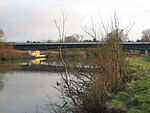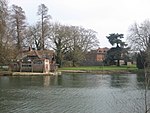St John the Baptist's Church, Mongewell
Church of England church buildings in OxfordshireChurch ruins in EnglandChurches preserved by the Churches Conservation TrustEnglish churches with Norman architectureFormer Church of England church buildings ... and 4 more
Gothic architecture in EnglandGrade II listed churches in OxfordshireGrade II listed ruinsRedundant churches

St John the Baptist's Church is a closed, redundant Anglican church, partly in ruins, in what has thus reverted to the hamlet of Mongewell, Oxfordshire, England. It is recorded in the National Heritage List for England as a designated Grade II listed building, and is under the care of the Churches Conservation Trust. The ruins stand on the east bank of the River Thames, next to the former Carmel College, to the north of Mongewell Park, 2.5 miles (4 km) south of Wallingford, and near The Ridgeway long-distance path. Local Anglicans are in the parish of North Stoke: St Mary the Virgin.
Excerpt from the Wikipedia article St John the Baptist's Church, Mongewell (License: CC BY-SA 3.0, Authors, Images).St John the Baptist's Church, Mongewell
Winterbrook Bridge, South Oxfordshire Winterbrook
Geographical coordinates (GPS) Address External links Nearby Places Show on map
Geographical coordinates (GPS)
| Latitude | Longitude |
|---|---|
| N 51.586 ° | E -1.123 ° |
Address
St John the Baptist
Winterbrook Bridge
OX10 8BZ South Oxfordshire, Winterbrook
England, United Kingdom
Open on Google Maps







